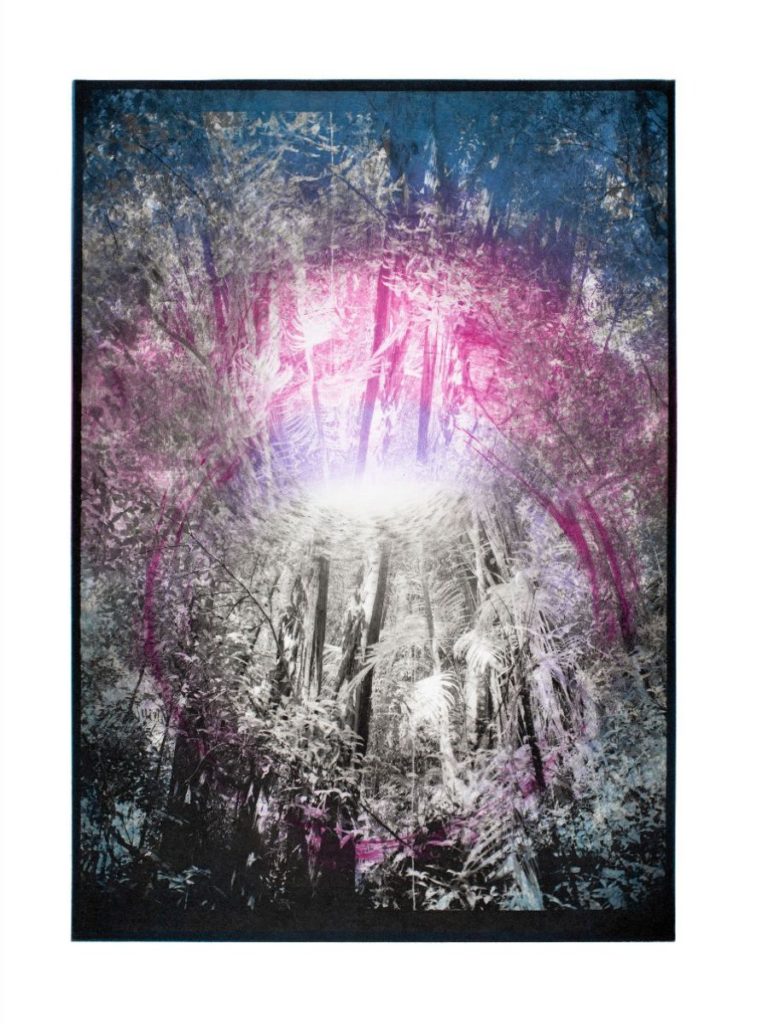In her new exhibition Drunken gods and a box of colours Heli Rekula has returned to the material she photographed in Mexico in autumn 1988. On her journey Rekula was caught in the middle of Hurricane Gilbert, in the eye of the storm on the Yucatán Peninsula. There was no escape, so the artist and her travelling companion were left to wait for the storm to die down. It lasted two days and left a powerful impression in the memory of the young photography student. Returning to the events of the journey via an exhibition now, 30 years later, is a way of investigating how looking at the world through the camera has changed, what was worth recording, and how an image was constructed. On the one hand, the passage of time has brought distance, while on the other, returning to these pictures has been a natural, meaningful thing to do. The storm is present in the works via satellite images. Of the photographs taken on the journey those that have ended up in the exhibition include images of rain forest, stray dogs and rock paving. The journey was to be an important experience, even though while it was happening, Rekula was not aware of what she could have done with the photographs. Now, decades later, going back to this material repositions the pictures in the artist’s production.
My notes are black and white and grey tones in between. No writing, no drawings. Photographs. Thirty rolls of film, of which eight rolls are missing today, nowhere to be found. Too many years in between, things tend to get lost. These photos were taken right before and after the storm. None during the eye. What was there to photograph, windows shuttered with plywood boards: the sound of the roaring wind and the rain, the dead calm between the walls of storm. In the quiet of the eye I looked out the window. I remember the stillness, the deep silence, the glowing purple-grey light casting no shadows.
At the heart of the exhibition are memories. Memory, remembering and memories are intrinsic to the nature of photography. Already in her last two solo exhibitions – InHemingway’s Garden at Helsinki Contemporary and As the Crow Flies at EMMA – Espoo Museum of Modern Art – Rekula has used image material acquired and assembled from various different archives for background research and for making works for the exhibition. Now, she has for the first time taken a look back at her own artistic past, at image material she herself has recorded. Rekula has often thought about how we would remember things and events if photography did not exist. It is typically human to doubt our own memories: are the things we remember imagined or real occurrences? Material recorded on camera serves as an aid to memory while, as a medium, it constructs new memories.
The pictures taken in Mexico tell us about subjective experiences, which Rekula now submits for public inspection in the form of artworks. The pictures taken on the trip acquire a new mode of existence through the artist’s choices, they become artworks, they face the public and endless reinterpretation.
Rekula has reworked the material using photogravure and silk-screen printing. Graphic techniques based on photography have been incorporated into her artistic working process via the Trykkeriet printmaking centre in Bergen, Norway. What interests Rekula in photogravure is the fragility of the three-colour process. A chance event will often occur in pulling the print: the printing plates may be out of register, or misaligned, so that the resultant image is disjointed. These chance occurrences are often interesting, making the aesthetics of error that has always fascinated Rekula a part of the artwork.
The title of the exhibition, Drunken gods and a box of colours, comes from the Mexican folk tale The Story of Colors*, which tells how a black-and-white planet got colours. The gods discover colours and share them with the world. The exhibition shows original material shot on black-and-white film that has been given colour – and hence a new form – during the physical, material process of graphic printing.
*[(Subcomandante Marcos, The Story of Colours, trans. Anne Bar Din (Guadalajara: Cinco Puntos Press, 1999)]
Gallery name: Helsinki Contemporary
Address: Bulevardi 10, Helsinki
Opening hours: Tue-Fri 12:00 - 18:00, Sat-Sun 12:00 - 16:00
Open: 04.10.2019 - 27.10.2019







